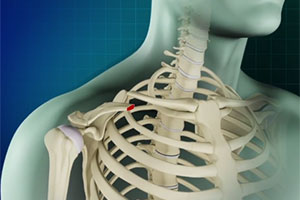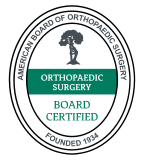Clavicle Fractures / ORIF

What is a Clavicle Fracture?
A clavicle fracture refers to a broken collarbone and is a common injury associated with contact sports such as football and martial arts, as well as impact sports such as motor racing. A direct blow over the shoulder, a fall on an outstretched arm, or a motor vehicle accident may also cause the clavicle bone to break. Most clavicle fractures occur in the shaft or middle portion of the bone. Clavicle fractures are quite common and occur in individuals of all ages.
What does ORIF mean?
ORIF/open reduction and internal fixation is a surgical procedure employed for the treatment of a clavicle fracture not amenable to non-surgical conservative treatment.
Normal Anatomy
The collar bone or clavicle is a bone situated horizontally, connecting the sternum (breastbone) to the humerus or bone of the upper arm, on either side of the body.
Signs and Symptoms of Clavicle Fractures
Signs and symptoms of a clavicle fracture may include:
- Swelling, tenderness, and/or bruising over the break
- Inability to lift the arm because of pain
- A bump or deformity over the break
- A sensation of grinding when you try to lift the arm
- Sagging of the shoulder forward and downward
Diagnosis of Clavicle Fractures
The diagnosis of a clavicle fracture comprises of a physical examination, X-ray imaging, and CT scan. Physical examination determines the site and location of the fracture. X-ray and CT scan help evaluate the type and severity of the fracture, and the presence of any other associated injuries.
Preparation for Surgery
Since ORIF is usually performed to treat a severe fracture, it often takes place as an emergency procedure following the injury. Prior to surgery, you may have the following:
- Physical exam to examine blood circulation and nerves affected by the fracture
- X-ray, CT scan, or MRI scan to assess surrounding structures and broken bones
- Blood tests
- Depending on the type of fracture you have sustained, you may be given a tetanus shot if you are not up to date with your immunizations
- A discussion with an anesthesiologist to determine the type of anesthesia you may undergo
- A discussion with your doctor about the medications and supplements you are taking and the need to stop any of these
Treatment for Clavicle Fractures
The management of a clavicle fracture is comprised of non-surgical and surgical methods. The choice of treatment depends on the type and location of the fracture.
Non-surgical Treatment
Nonsurgical approach involves placing your arm in a sling to immobilize the bones and allow healing, medications and supplements to promote healing and relieve pain, and physical therapy to prevent stiffness and weakness of the shoulder, restore range of motion, and strengthen muscles.
Surgical Treatment
Open reduction and internal fixation is the procedure most commonly used to treat clavicle fractures.
The surgery is performed under sterile conditions in the operating room under general anesthesia.
- After sterilizing the affected area, your surgeon will make small incisions around the clavicle muscles.
- Your surgeon will locate the fracture by carefully sliding in between the muscles of the clavicle. This technique allows your surgeon to see the fracture without cutting directly through the muscles.
- Special instruments are used to reposition (reduce) the bone fragments into their normal alignment.
- Bone fragments are then held in place with special metal hardware such as metal wires, plates, pins, or screws.
- After securing the bone, the incisions are closed by sutures or tape and sterile dressings applied.
Postoperative Care
You will experience some pain post procedure and pain medication will be prescribed to keep you comfortable. You will need to keep your arm immobile for several weeks by wearing a sling to allow the bone to heal. Your doctor will provide instructions on care of the incision along with applying ice packs to relieve discomfort.
Physical therapy and an exercise regimen is suggested to prevent shoulder stiffness, strengthen muscles, and restore range of motion. You will also be advised on diet and supplements high in vitamin D and calcium to promote bone healing. Depending on your health condition and the extent of the injury, you may be able to go home the same day.
Risks and Complications
As with any surgery, some of the potential complications of an ORIF procedure may include:
- Bleeding
- Infection
- Pain
- Anesthetic reactions
- Blood clots or deep venous thrombosis
- Damage to nerves and blood vessels
- Shoulder stiffness
- Hardware irritation
- Failure in bone healing













